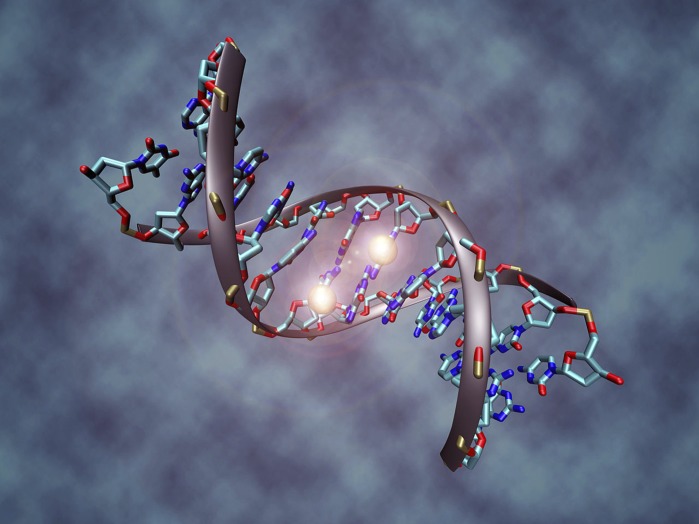This image shows a DNA molecule that is methylated on both strands on the center cytosine. DNA methylation plays an important role for epigenetic gene regulation in development and cancer. Image courtesy Christoph Bock, Max Planck Institute for Informatics.
Despite the fact that every cell in a human body contains the same genetic material, not every cell looks or behaves the same. Long nerve cells stretch out the entire length of an arm or a leg; cells in the retina of the eye can sense light; immune cells patrol the body for invaders to destroy. How does each cell retain its unique properties when, in its DNA-containing nucleus, it has the same master set of genes as every other cell? The answer is in the epigenetic regulation of the genes: the control system that dictates which of many genes a cell uses and which it ignores. The same mechanism could also explain why identical twins—who have identical genes—can develop different diseases, traits, or personalities.
Epigenetic regulation consists of chemical flags, or markers, on genes that are copied along with the genes when the DNA is replicated. Without altering the sequence of DNA’s molecular building blocks, epigenetic changes can alter the way a cell interacts with DNA. These changes can block a cell’s access to a gene, turning it off for good.
In 1975, scientists published the first evidence that the addition of certain chemicals—methyl groups—to DNA could inactivate genes in cells. In addition, adding different chemicals that destroyed methyl groups often turned such genes back on. As time went on, researchers revealed that methylation wasn’t the only such epigenetic factor in determining which genes a cell had on and off. DNA spends most of its time wound in dense coils around proteins called histones. The placement of histones, it turns out, is a form of epigenetic regulation too. When genes are tightly associated with histones, the cell’s gene-reading machinery can’t get access. Different chemical changes on the surface of histones, scientists have found, can change the association of the protein with a particular area of DNA.
For much of the past few decades scientists have been on the hunt for gene variants or mutations that explain people’s susceptibility to diseases, from autism to cancer to Alzheimer’s. However, in many cases, studies trying to correlate genes with diseases have come up empty-handed. Now, biologists believe that understanding epigenetics may be key to explaining diseases that don’t have clear-cut genetic causes. If two people have the same copy of a gene, but one of them has it turned on and the other has it epigenetically silenced, they could have different risks of developing a disease despite identical genetics.
An equally intriguing idea that is gaining evidence to support it is that, even though it can’t change the genes his or her cells contain, a person’s environment could alter the epigenetic regulation of those genes. Therefore, if those epigenetic marks can be passed between generations, it could provide an answer for how exposure of a parent, or even a grandparent, to a chemical has been shown to alter a child’s disease susceptibility a generation or two later.
Where genetics has fallen short in explaining human biology, epigenetics is stepping up to fill in gaps. However, although the cost and difficulty of sequencing a person’s genes has rapidly fallen, the technology to get a read on a person’s epigenome has a long way to go to catch up. Only then will the full role of epigenetics in human health and biology emerge.



